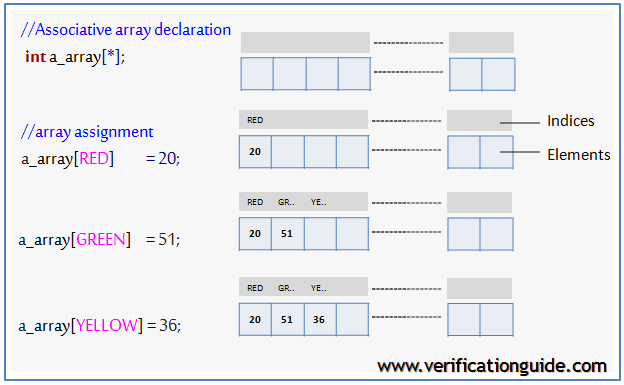Queue in SystemVerilog
A queue is a variable-size, ordered collection of homogeneous elements.
- like a dynamic array, queues can grow and shrink
- queue supports adding and removing elements anywhere
Queues are declared using the same syntax as unpacked arrays, but specifying $ as the array size. In queue 0 represents the first, and $ representing the last entries.
A queue can be bounded or unbounded.
- bounded queue – queue with the number of entries limited or queue size specified
- unbounded queue – queue with unlimited entries or queue size not specified
Queue Declaration
data_type queue_name[$];
where:
data_type – data type of the queue elements.
queue_name – name of the queue.
Queue Declaration Example
bit queue_1[$]; // queue of bits (unbound queue) int queue_2[$]; // queue of int byte queue_3[$:255]; // queue of byte (bounded queue with 256 entries) string queue_4[$]; // queue of strings
Queue Initialization
queue_1 = {0,1,2,3};
queue_4 = {“Red”,"Blue”,"Green”};
Unbounded Queue
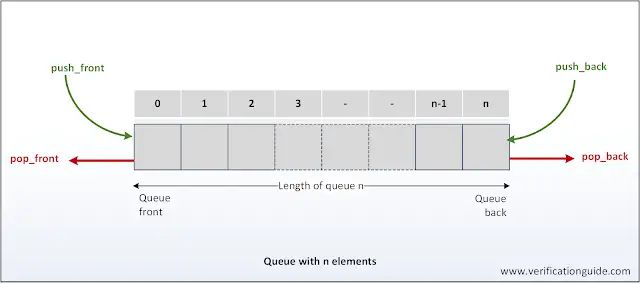
Bounded Queue
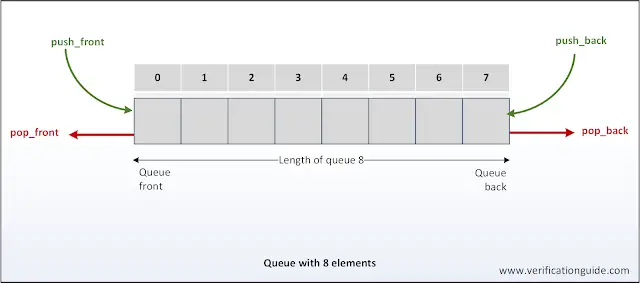
Queue Methods
| Method | Description |
|---|---|
| size() | returns the number of items in the queue |
| insert() | inserts the given item at the specified index position |
| delete() | deletes the item at the specified index position |
| push_front() | inserts the given element at the front of the queue |
| push_back() | inserts the given element at the end of the queue |
| pop_front() | removes and returns the first element of the queue |
| pop_back() | removes and returns the last element of the queue |
Queue Methods Example
Unbounded Queue Declaration, Initialization, Size, Insert and Delete Method
This example shows the declaration and usage Queue methods.
module queues_array;
//declaration
bit [31:0] queue_1[$]; //unbounded queue
string queue_2[$];
initial begin
//Queue Initialization:
queue_1 = {0,1,2,3};
queue_2 = {"Red","Blue","Green"};
//Size-Method
$display("----- Queue_1 size is %0d -----",queue_1.size());
foreach(queue_1[i]) $display("\tqueue_1[%0d] = %0d",i,queue_1[i]);
$display("----- Queue_2 size is %0d -----",queue_2.size());
foreach(queue_2[i]) $display("\tqueue_2[%0d] = %0s",i,queue_2[i]);
//Insert-Method
queue_2.insert(1,"Orange");
$display("----- Queue_2 size after inserting Orange is %0d -----",queue_2.size());
foreach(queue_2[i]) $display("\tqueue_2[%0d] = %0s",i,queue_2[i]);
//Delete Method
queue_2.delete(3);
$display("----- Queue_2 size after Delete is %0d -----",queue_2.size());
foreach(queue_2[i])$display("\tqueue_2[%0d] = %0s",i,queue_2[i]);
end
endmodule
Simulator Output:
----- Queue_1 size is 4 ----- queue_1[0] = 0 queue_1[1] = 1 queue_1[2] = 2 queue_1[3] = 3 ----- Queue_2 size is 3 ----- queue_2[0] = Red queue_2[1] = Blue queue_2[2] = Green ----- Queue_2 size after inserting Orange is 4 ----- queue_2[0] = Red queue_2[1] = Orange queue_2[2] = Blue queue_2[3] = Green ----- Queue_2 size after Delete is 3 ----- queue_2[0] = Red queue_2[1] = Orange queue_2[2] = Blue
Queue, push_front(), push_back(), pop_front() and pop_back() Method
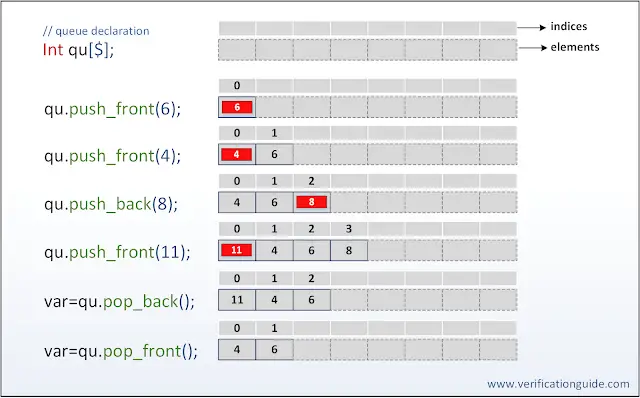
module queues_array;
//declaration
bit [31:0] queue_1[$];
int lvar;
initial begin
//Queue Initialization:
queue_1 = {0,1,2,3};
//Size-Method
$display("\tQueue_1 size is %0d",queue_1.size());
//Push_front Method
queue_1.push_front(22);
$display("\tQueue_1 size after push_front is %0d",queue_1.size());
//Push_back Method
queue_1.push_back(44);
$display("\tQueue_1 size after push_back is %0d",queue_1.size());
//Pop_front Method
lvar = queue_1.pop_front();
$display("\tQueue_1 pop_front value is %0d",lvar);
//Pop_back Method
lvar = queue_1.pop_back();
$display("\tQueue_1 pop_back value is %0d",lvar);
end
endmodule
Simulator Output:
Queue_1 size is 4 Queue_1 size after push_front is 5 Queue_1 size after push_back is 6 Queue_1 pop_front value is 22 Queue_1 pop_back value is 44
Bounded queue declaration and accessing
The number of entries of the bounded queue is limited, push_back to the bounded queue (after the queue full condition) will not impact any changes to the queue. push_front to the bounded queue (after the queue full condition) will delete the last entry from queue and stores a new entry in the 0th index of the queue.
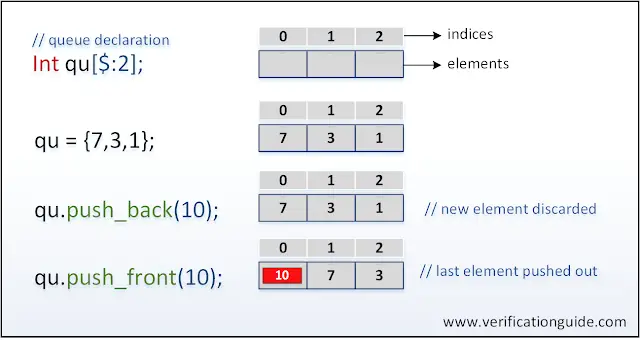
module queues_array;
//declaration
int queue[$:2];
int index;
int temp_var;
initial begin
//Queue Initialization:
queue = {7,3,1};
$display("Queue elements are,");
$display("\tqueue = %p",queue);
queue.push_back(10);
$display("After push_back Queue elements are,");
$display("\tqueue = %p",queue);
queue.push_front(10);
$display("After push_front Queue elements are,");
$display("\tqueue = %p",queue);
end
endmodule
Simulator Output:
Queue elements are,
queue = '{7, 3, 1}
After push_back Queue elements are,
queue = '{7, 3, 1}
After push_front Queue elements are,
queue = '{10, 7, 3}
Accessing random element of queue
In the below example, random queue entry will be accessed by using index. Unlike pop_front/pop_back option queue entry will not get deleted on accessing with an index of the queue.
module queues_array;
//declaration
int queue[$];
int index;
int temp_var;
initial begin
//Queue Initialization:
queue = {7,3,1,0,8};
$display("----- Queue elements with index -----");
foreach(queue[i])
$display("\tqueue[%0d] = %0d",i,queue[i]);
$display("-------------------------------------\n");
$display("Before Queue size is %0d",queue.size());
repeat(2) begin //{
index = $urandom_range(0,4); //index of queue is from 0 to 4
temp_var = queue[index];
$display("Value of Index %0d in Queue is %0d",index,temp_var);
end //}
$display("After Queue size is %0d",queue.size());
end
endmodule
Simulator Output:
----- Queue elements with index ----- queue[0] = 7 queue[1] = 3 queue[2] = 1 queue[3] = 0 queue[4] = 8 ------------------------------------- Before Queue size is 5 Value of Index 3 in Queue is 0 Value of Index 0 in Queue is 7 After Queue size is 5
Deleting random element of queue with index
Calling queue.delete(index) method will delete the entry stored with ‘index’.
module queues;
//declaration
int queue[$];
int index;
int temp_var;
initial begin
//Queue Initialization:
queue = {7,3,1,0,8};
$display("Queue entries are %p",queue);
$display("Before Queue size is %0d",queue.size());
index = $urandom_range(0,4); //index of queue is from 0 to 4
$display("Index %0d is deleted",index);
queue.delete(index);
$display("After Queue size is %0d",queue.size());
$display("Queue entries are %p",queue);
$display("\nQueue entries are %p",queue);
$display("Before Queue size is %0d",queue.size());
index = $urandom_range(0,3); //index of queue is from 0 to 4
$display("Index %0d is deleted",index);
queue.delete(index);
$display("After Queue size is %0d",queue.size());
$display("Queue entries are %p",queue);
end
endmodule
Simulator Output:
Queue entries are '{7, 3, 1, 0, 8}
Before Queue size is 5
Index 3 is deleted
After Queue size is 4
Queue entries are '{7, 3, 1, 8}
Queue entries are '{7, 3, 1, 8}
Before Queue size is 4
Index 0 is deleted
After Queue size is 3
Queue entries are '{3, 1, 8}
Deleting complete queue
Calling queue.delete() method will delete the complete queue, which leads to the deletion of all the entries of the queue.
module qu_delete;
//queue declaration
int qu[$];
initial begin
qu.push_back(2);
qu.push_back(13);
qu.push_back(5);
qu.push_back(65);
$display("[Before-Delete] Queue size is %0d",qu.size());
qu.delete();
$display("[After -Delete] Queue size is %0d",qu.size());
end
endmodule
Simulator Output:
[Before-Delete] Queue size is 4 [After -Delete] Queue size is 0

